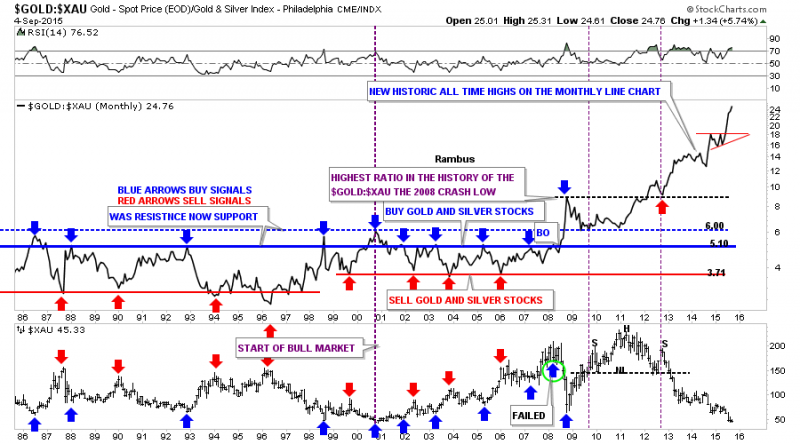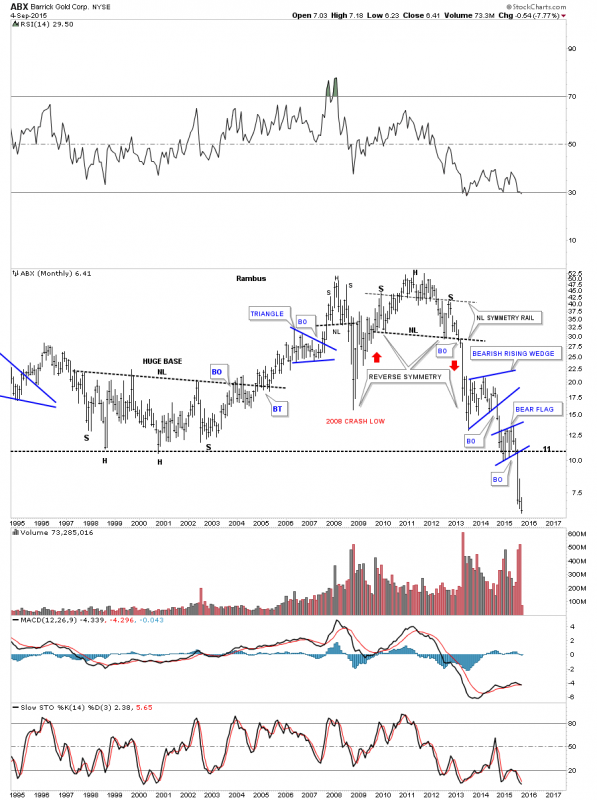In this report I’m going to take an in-depth look at some of the individual precious metals stocks so we can see where things stand for each of them from a short to long term perspective. We’ll start by looking at some of the more important big cap PM stocks as the precious metals stock indexes can’t have a significant rally until this group is ready to run.
Of course, anything can happen in the very short term, but the further out in time you go, the less likely the big trend is going to change on a dime.
The first stock we’ll look at will be a daily chart of Barrick Gold Corporation (NYSE:ABX) which is one of the biggest of the largee caps. From late last year to July of this year, ABX built out a shallow bear flag consolidation pattern. The breakout led to our most recent lows around the 6.50 area.
Last Friday the stock gapped below the bottom black-dashed S&R line and back-tested it at the end of the day. So on the very short term time frame, ABX is testing overhead resistance at 6.50.
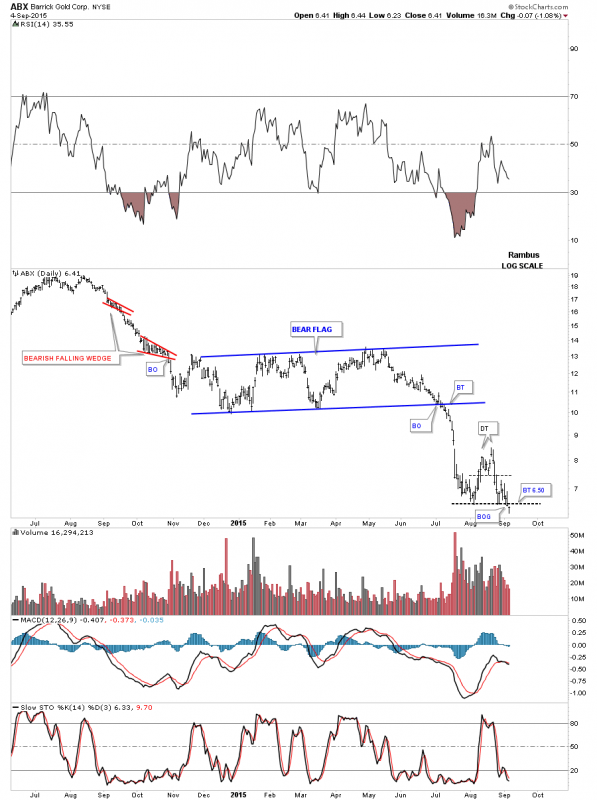
The long term weekly chart shows the massive H&S top ABX built out, which reversed its bull market, turning the uptrend into a downtrend as shown by all the consolidation patterns. The close on Friday marked ABX's lowest closing price since the bear market started in 2011—which is a milestone in its own right. You can see how the blue bear flag on the daily chart above fits into the bear market downtrend.
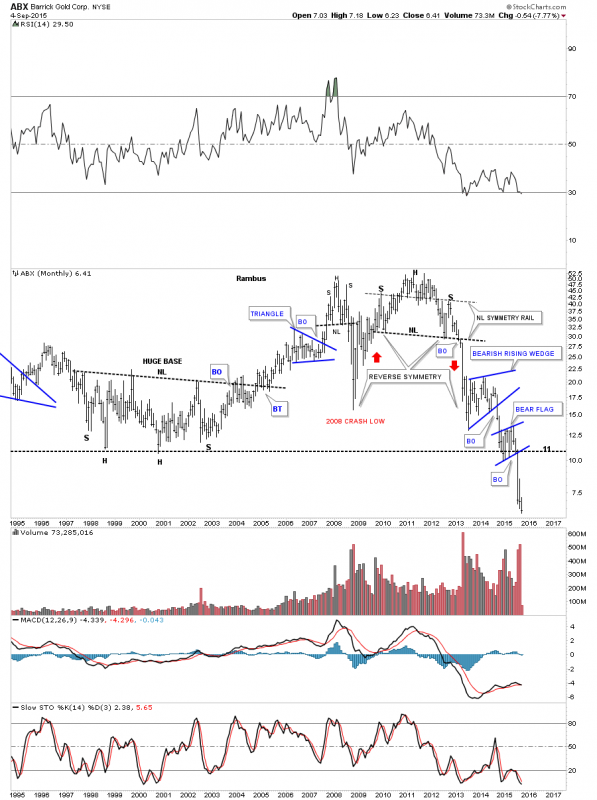
The 20 year monthly chart, below, shows the massive inverse H&S bottom ABX built out in the late 1990sthrough the early 2000s which led to its bull market run. That major low came in around $11.
What this chart so clearly shows is that ABX has now taken out 2008's major low and now the other major low as well, at the bear market bottom in the late 1990s. Note how the recent blue bear flag formed right on that important bottom rail in the 1990’s, signalling that if it broke to the downside, new lows would quickly follow.
As you can see, ABX has been in free-fall since the break below the bottom rail of the blue bear flag and the horizontal support and resistance line at $11. This move down could very well mark the capitulation move is underway.
Let's look at the 30 year monthly chart for ABX, below, which shows how important that late 1990s – early 2000s bottom is. I've labeled is as the support and resistance line. The number one rule in Chartology is that once an important support line is broken to the downside, it then reverses its role and acts as resistance on any counter-trend rally. That S&R line is almost 25 years old which makes it very important.
There is one other piece of Chartology on this long term monthly chart, and that is the neckline extension rail that I took off of the 2000 inverse H&S bottom and extended all the way out to the right hand side of the chart. The black arrows show how it has reversed its role several times, from resistance to support and back to resistance again.
The bearish setup here on this very long term chart shows how ABX formed the blue bearish rising wedge on top of the neckline extension rail and the red bearish rising flag formed just below it, which I’ve shown in the past is a bearish situation. That neckline extension rail is the same concept that I’ve been showing on the long term chart for gold where I extended the neckline, all the way out to the right hand side of the chart, made during the 2008 crash low. I find this chart a little scary, particularly once we broke below the all important 2000 low.
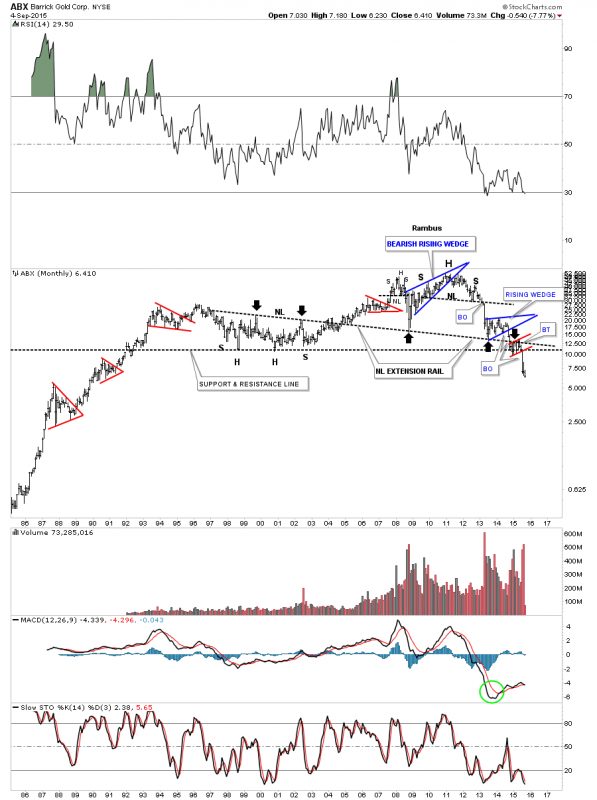
Newmont Mining Corporation (NYSE:NEM) is another big cap PM stock that's not looking very healthy at the moment on the short term daily chart. After forming a six month bearish rising wedge, NEM broke to the downside, finding initial support at the August low. At this point it looks like it has broken down from a small red bearish rising wedge and is testing the previous August low again.

The weekly line chart for NEM, below, does a good job of showing you how support and resistance works. Initially, NEM bounced off its 2008 crash low, building out the blue bearish rising wedge. After cracking the 2008 crash low late last year, NEM put on a surprising rally that broke back above the 2008 crash low which looked like it may have legs to run higher.
As you can see though, it barley moved above the top of the blue bearish falling wedge where it put in a double top that reversed the little counter trend rally which I’m sure trapped a lot of gold bugs looking for higher prices.
The initial low, made late last year, worked as resistance two weeks ago, as shown by the black arrow. At the close of trading last Friday, NEM made a new multi year low on a closing basis.
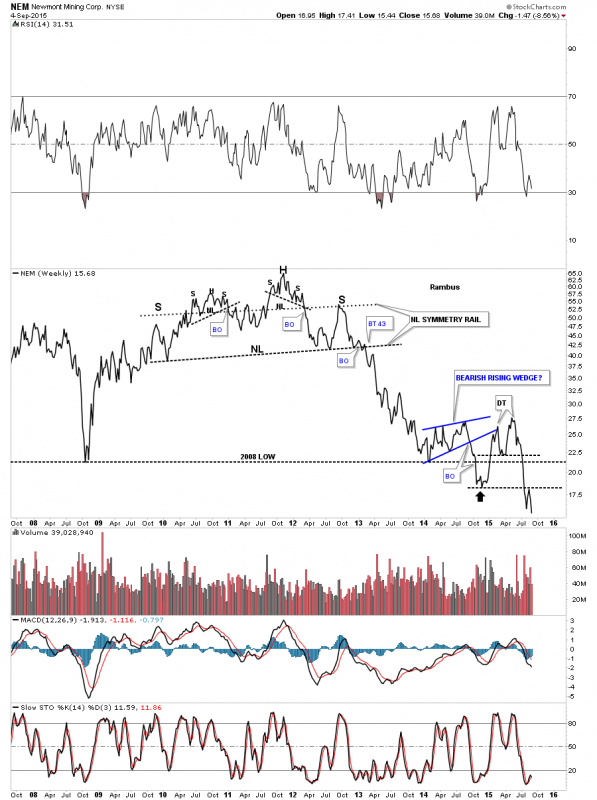
Next is a weekly bar chart for NEM which shows how it’s interacting with the 2008 crash low. It formed a small double bottom on the 2008 trendline, which led to a small counter trend rally where it built out a small double top. This led to our most recent multi year low. Note the one last backtest to the horizontal 2008 crash low trendline at 19.00. That’s how you take out an important trendline. You get a bounce, followed by the break, and then one last test from below to complete the breakout process.
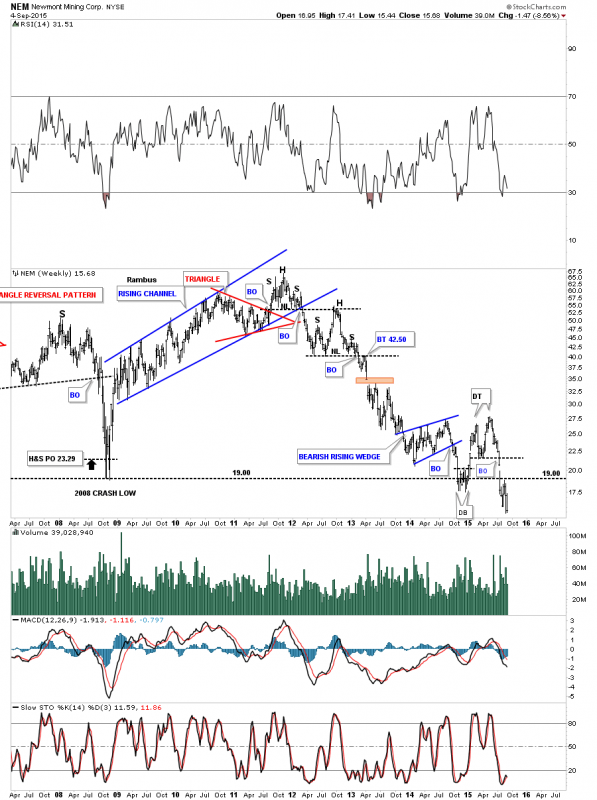
The 20 year monthly chart, below, for NEM shows a possible interesting set-up from the long term perspective. NEM built out a big H&S top that marked the beginning of the 2008 crash. After finding the bottom, NEM rallied right back up again to form a second H&S top, which matches the first one in height. On this monthly chart I labeled the most recent consolidation pattern as a Diamond. Note the big breakout bar that occurred once the bottom rail of the blue Diamond gave way, then the subtly backtest last month to the 2008 crash low. There really isn’t much support until the big bottom in 2000 is reached
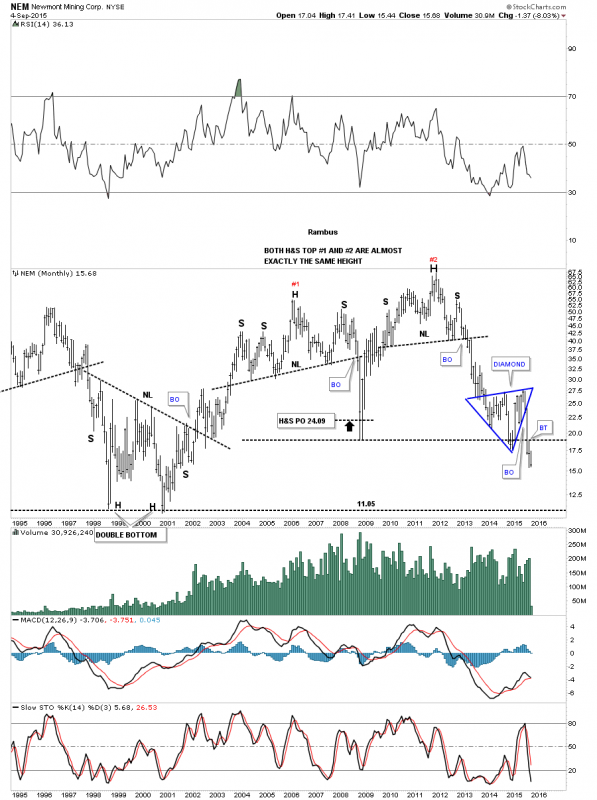
Let's look at one last royalty company that was everyone’s favorite stock during the bull market years, Silver Wheaton (NYSE:SLW). This daily chart shows the triangle consolidation pattern that broke down in June. This stock illustrates one of the reasons I bought the Kamikaze stocks last week. As the ARCA Gold Miners Index (GDM) and Market Vectors Gold Miners ETF (NYSE:GDX) are showing a possible H&S consolidation pattern, SLW formed a small blue bearish expanding rising wedge pattern that I’m looking at as a possible halfway pattern between the breakout from the black triangle to where the next low comes in.
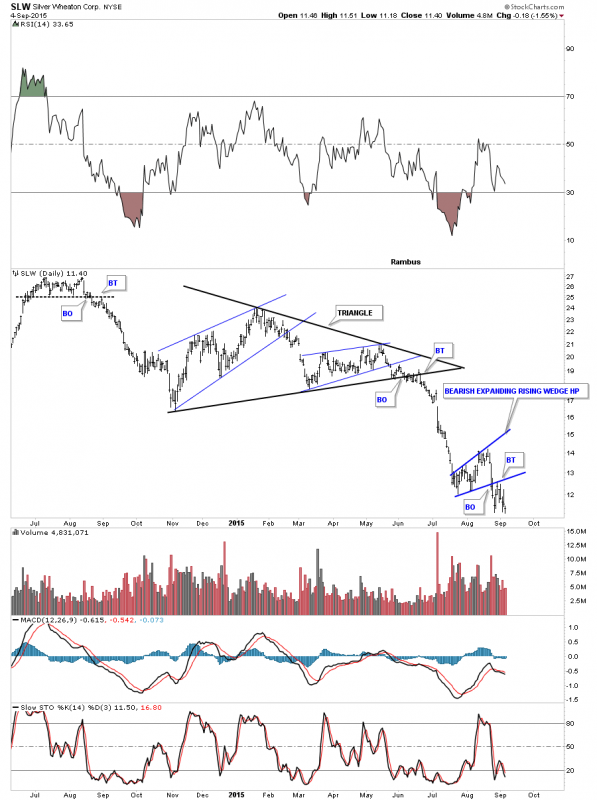
There are several different ways we can look at the long term charts for SLW. Below is a weekly chart which shows the defining black dashed support and resistance line—it's bullish above and bearish below.
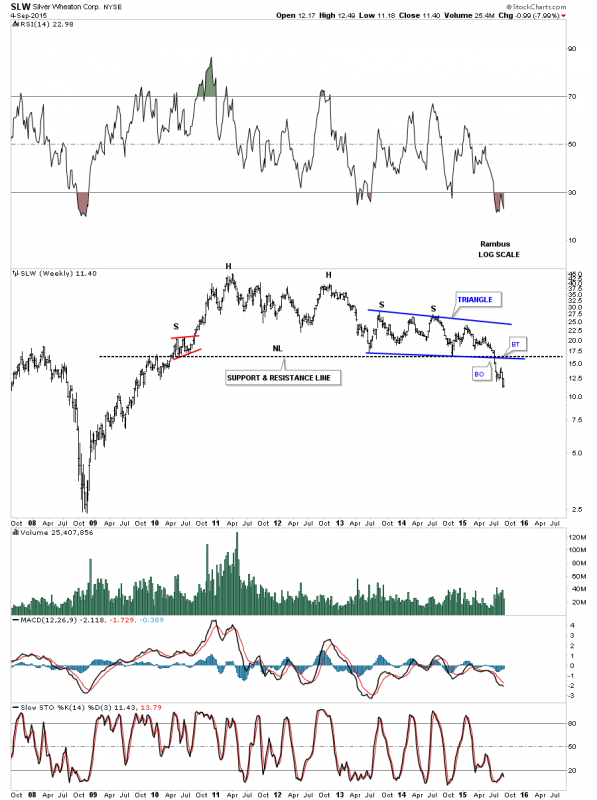
This next long term weekly chart shows a possible expanding falling wedge, which SLW tested the bottom rail of again last week. This looks like a promising pattern but I’m seeing similar patterns where the price action is breaking below the bottom rail. At this point the bottom rail has held support, which we have to respect.

When I look at the long term, monthly line chart for SLW, below, I don’t get a warm fuzzy feeling that the worst is over for this darling among PM stocks. It formed a rather ugly double top that reversed its bull market. It then formed a six point blue triangle consolidation pattern which broke out to the downside and had a strong backtest. The strong backtest started at the S&R line which was holding support from the 2007 high. If there was ever a place to look for some reverse symmetry, this monthly chart shows how it may play out, red arrows.
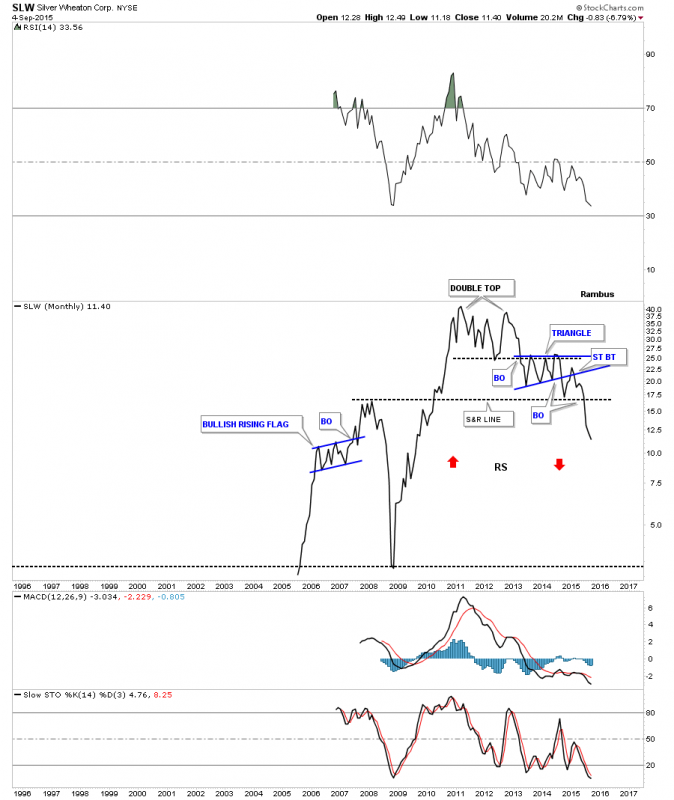
Some readers may remember this long term weekly combo chart for the HUI:Gold ratio. Several years ago I flagged the .13 low as a very important low for this ratio. It seemed like it would never get down there but it did, whereupon it formed a small H&S consolidation pattern on that low that goes all the way back to the beginning of the bull market for the HUI.
One would assume this point just had to be as low as this ratio could possibly go, right? Gold stocks versus Gold had finally bottomed, a 15 year round trip was finally over. Now the PMs could finally go up again, right? Surprisingly, the ratio has now hit .10, with no bottom pattern in sight as yet .
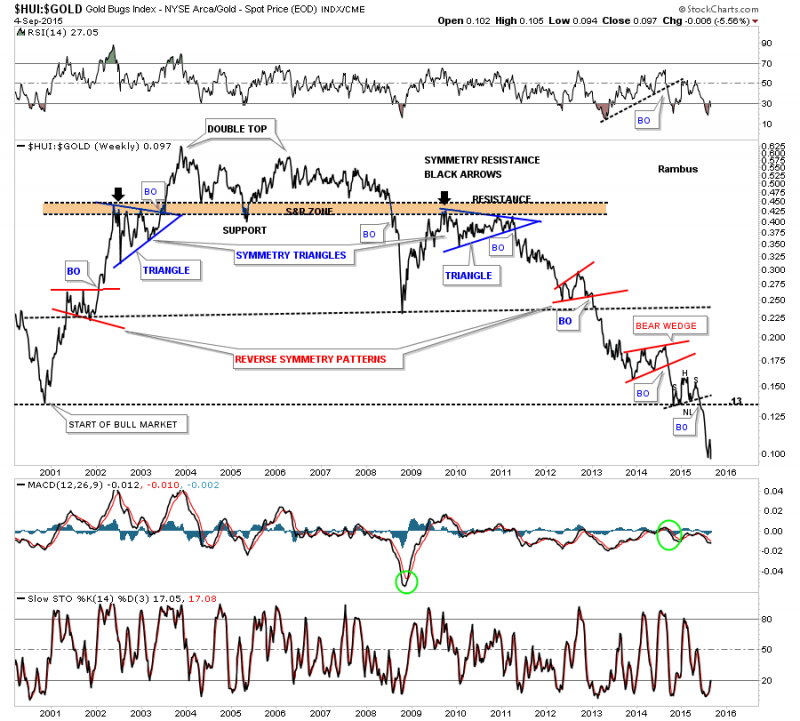
This last chart compares gold to the Philadelphia Gold/Silver Index (XAU) which has the longest history of all the PM stock indexes we follow. This 30 year ratio chart, below, shows gold is still outperforming the XAU which is unbelievable in its magnitude.
Whatever happened during the 2008 crash had a profound impact on this ratio. Up until then this chart was money in the bank. Whenever this ratio got up to the blue line you would buy the PM stocks; When it got down to the red line, you would sell.
I marked the failure back in 2008 with the green circle around the blue arrow. That’s when everything changed for this ratio chart. The under-performance of the stocks that make up the XAU is truly amazing. As you can see, even to this day the XAU is still underperforming gold. This chart doesn’t tell us what the issue is with the PM stocks, it only indicates that something is very wrong. Maybe someday we’ll know the answer to that question.
